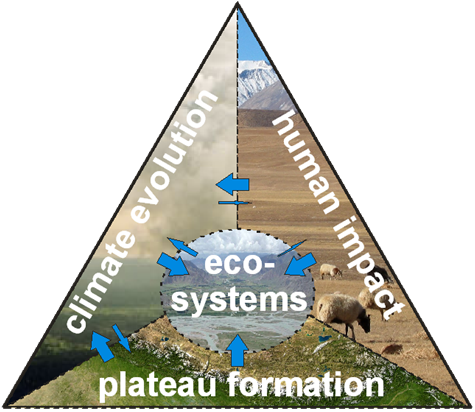| Hafner, S; Unteregelsbacher, S; Seeber, E; Becker, L; Xu, X; Li, X; Guggenberger, G; Miehe, G; Kuzyakov, Y: Effect of grazing on carbon stocks and assimilate partitioning in a Tibetan montane pasture revealed by 13CO2 pulse labeling, Global Change Biology(18), 528–538 (2012) | |
| Stichworte: 13C pulse labeling; C allocation; grazing exclosure experiment; grazing intensity; montane Kobresia pasture; Qinghai-Tibetan Plateau; soil organic carbon | |
| Abstract: Since the late 1950s, governmental rangeland policies have changed the grazing management on the Tibetan Plateau (TP). Increasing grazing pressure and, since the 1980s, the privatization and fencing of pastures near villages has led to land degradation, whereas remote pastures have recovered from stronger overgrazing. To clarify the effect of moderate grazing on the carbon (C) cycle of the TP, we investigated differences in below-ground C stocks and C allocation using in situ13CO2 pulse labeling of (i) a montane Kobresia winter pasture of yaks, with moderate grazing regime and (ii) a 7-year-old grazing exclosure plot, both in 3440 m asl. Twenty-seven days after the labeling, 13C incorporated into shoots did not differ between the grazed (43% of recovered 13C) and ungrazed (38%) plots. In the grazed plots, however, less C was lost by shoot respiration (17% vs. 42%), and more was translocated below-ground (40% vs. 20%). Within the below-ground pools, <2% of 13C was incorporated into living root tissue of both land use types. In the grazed plots about twice the amount of 13C remained in soil (18%) and was mineralized to CO2 (20%) as compared to the ungrazed plots (soil 10%; CO2 9%). Despite the higher contribution of root-derived C to CO2 efflux, total CO2 efflux did not differ between the two land use types. C stocks in the soil layers 0–5 and 5–15 cm under grazed grassland were significantly larger than in the ungrazed grassland. However, C stocks below 15 cm were not affected after 7 years without grazing. We conclude that the larger below-ground C allocation of plants, the larger amount of recently assimilated C remaining in the soil, and less soil organic matter-derived CO2 efflux create a positive effect of moderate grazing on soil C input and C sequestration. |

